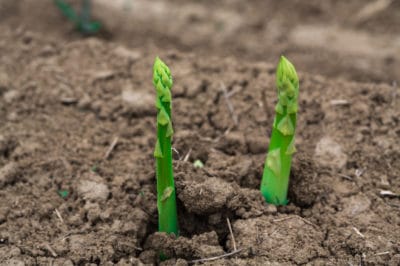How Long Asparagus Plants Need to Grow
Asparagus plants start as seeds, but most often it is commercial nurseries who start the plants this way, and most home gardeners start their asparagus bed from crowns, started and grown by a nursery for one to two years.
Establish crowns in the garden in late fall to early spring, depending on your location. The plants must then grow until they produce shoots for the third year before you harvest more than a few.
The schedule for harvesting asparagus as it grows for the first years is:
- 1st year: Do not harvest any spears.
- 2nd year: Harvest only a few spears in the first 3 to 4 weeks they appear.
- 3rd years: Harvest spears through May.
- 4th year and beyond: Harvest spears up to the middle or end of June.
The reason for this schedule is that newly planted asparagus plants need time for developing extensive roots systems for producing all of those shoots you like to eat. They need several growing seasons to grow and develop, until they have the stored energy needed for supplying you with a reliable and abundant crop of tender shoots each spring.
The shoots which mature and become full-grown plants supply the root system with energy and nutrients through their leaves. Full-grown asparagus plants reach as high as 4 to 5 feet (1.2 to 1.5 meters) tall, and their shade can provide a garden area for plants preferring less light.
Tending Asparagus as it Grows
Asparagus plants need the most water after they have produced their yearly crop of shoots and some have matured into tall, ferny-leaved stalks. At this time, the plant’s uptake of water increases, and soil should remain moist without becoming soggy.
Fertilize plants in early spring before the shoots first appear during the first few years after planting. After that, fertilize after harvest in June, applying approximately 1 pound (.45kg) of a 10-10-10 fertilizer for each 100 square feet (9.3 square meters) of garden bed.
As summer turns to fall, the plants begin to die-back, and irrigation can be reduced and then stopped altogether, allowing the roots to go into a dormant stage for winter. Cut dead foliage off of the plants at the ground level, and mulch the bed for winter. In the spring, rake the mulch aside so the ground can warm up more quickly.
